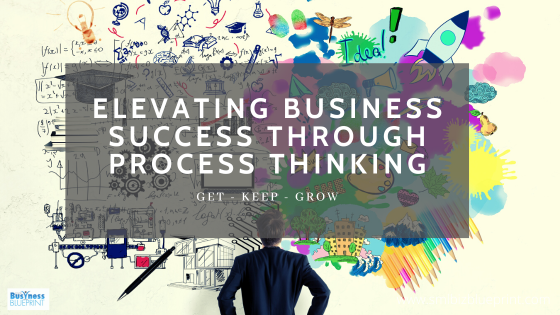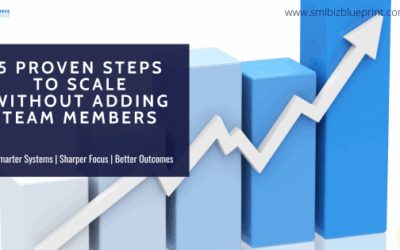As business owners, we struggle daily with enhancing our business’s efficiency and effectiveness—a commitment that defines our dedication to our enterprises and teams.
This article aims to extend a helping hand by illustrating how the strategic use of processes can dramatically improve your business operations. Through process thinking, we’ll explore actionable strategies for optimising key areas such as lead generation, customer service, and staff development.
By the end of this guide, you’ll be equipped with the knowledge to implement process-oriented improvements that can transform your business, setting the stage for sustained growth and success. Let’s dive into how processes can become the cornerstone of your business’s evolution.

The Essence of Process Thinking in Business
At the heart of every thriving business lies a foundation of well-structured processes.
Process thinking is not just a methodology; it’s a mindset that views every aspect of business operations as a series of interconnected steps, each capable of being measured, analysed and improved.
This approach allows us to see beyond individual tasks and consider the broader impact of how these tasks interlink and contribute to overall business objectives.
Imagine your business as a complex machine. No matter how small, each gear and cog plays a crucial role in the machine’s overall performance.
Process thinking encourages us to examine these ‘gears’—our business processes—to ensure they are well-oiled, efficiently interlocked, and tuned to perform optimally.
Every process is a potential goldmine for improvement and innovation, from the initial lead generation to the final customer follow-up.
By adopting a process-oriented mindset, we position ourselves to identify bottlenecks, eliminate inefficiencies, and enhance productivity. This leads to immediate operational improvements and fosters a continuous enhancement culture where every team member attains efficiency and effectiveness principles.
In the following sections, we’ll break down specific business processes and provide actionable insights on how to apply process thinking to each.
Our journey will take us through optimising lead generation efforts, streamlining follow-up procedures, maximising sales conversions, and beyond.
With each step, you’ll gain practical strategies to elevate your business’s performance and achieve your goals with unprecedented precision and success.
Optimising the Lead Generation Process
Lead generation stands as the vanguard of your business’s growth strategy. It’s how potential clients are identified, attracted, and brought into your sales funnel. Yet, despite its importance, many businesses struggle to create a lead-generation process that consistently delivers high-quality leads.
This is where process thinking can make a significant difference.
Identifying Your Ideal Customer
The first step in optimising your lead generation process is to clearly define who your ideal customer is. This involves understanding their needs, pain points, and where they spend their time.
Process thinking encourages us to segment our audience and tailor our messaging to speak directly to the needs of each group, dramatically increasing the effectiveness of our lead-generation efforts.
Leveraging the Right Channels
Not all lead generation channels are created equal, and what works for one business may not work for another. By applying process thinking, we can systematically test and measure the effectiveness of different channels, whether it be social media, email marketing, content marketing, or networking events.
This data-driven approach allows us to focus our efforts on the channels that yield the best return on investment.
Creating Compelling Offers
Your lead magnet, whether an ebook, a webinar, or a free consultation, is crucial in converting prospects into leads. Here, process thinking guides us to continuously refine our offers based on feedback and performance metrics, ensuring they resonate with our target audience and effectively address their needs.
Automating and Streamlining
Automation tools can significantly enhance the efficiency of your lead-generation process.
From scheduling social media posts to sending automated email sequences, the right tools can save valuable time and ensure your lead generation engine runs smoothly. Process thinking encourages us to map out each step of the lead generation process and identify opportunities for automation and optimisation.
Measuring Success
Finally, no process is complete without a mechanism for measurement and analysis.
Establishing clear metrics for your lead generation process, such as conversion rates, cost per lead, and lead quality, allows you to gauge the effectiveness of your strategies and make informed decisions on where to focus your improvement efforts.
By embracing process thinking in your lead generation efforts, you can create a more efficient, effective, and scalable system that drives your business forward. In the following sections, we’ll apply the same principles to other critical business processes, further unlocking the potential for growth and success.
Streamlining the Follow-Up Process
The follow-up process is where potential leads are nurtured and guided through the sales funnel, transforming interest into commitment.
A well-structured follow-up strategy boosts conversion rates and builds trust and rapport with potential customers. Let’s dive into how process thinking can refine this crucial aspect of your business.
Timeliness and Consistency
In follow-up, timing is everything. Responding promptly to inquiries and maintaining regular contact keeps your business top-of-mind for potential clients.
Process thinking encourages us to establish a standardised follow-up timeline, ensuring no lead is left untouched or forgotten. Automating initial responses and scheduling regular follow-up communications can maintain consistency without overwhelming your team.
Personalisation at Scale
While automation can enhance efficiency, personalisation bridges the gap between a business and its potential customers.
Process thinking involves segmenting leads based on their interests, behaviours, and previous interactions with your business. This segmentation allows for more tailored communications that resonate with each lead, increasing the likelihood of conversion.
Feedback Loops
Incorporating feedback loops into your follow-up process enables continuous improvement.
By systematically gathering and analysing feedback from potential customers, you can identify what’s working and what’s not. This may involve A/B testing different follow-up strategies, messaging, or intervals to refine your approach based on actual data.
Leveraging Technology
CRM (Customer Relationship Management) systems are pivotal in optimising the follow-up process. They allow you to track interactions, schedule communications, and store valuable customer information.
Integrating CRM systems into your follow-up process ensures no opportunity is missed and the lead’s history and preferences inform every communication.
Training Your Team
Your team’s skill in managing follow-ups can significantly impact their effectiveness. Process thinking advocates for regular training sessions to equip your team with the latest best practices, tools, and communication strategies.
Role-playing scenarios, reviewing successful cases, and continuous feedback can help refine their approach.
By applying process thinking to your follow-up process, you can create a more dynamic, responsive, and effective system that converts leads into customers and fosters lasting relationships. In the following sections, we’ll explore how these principles can be extended to other areas of your business, further driving efficiency and growth.

Enhancing the Sales Process for Higher Conversion
The sales process is the critical bridge between potential interest and actual purchase. It’s where the value proposition is clearly articulated, and customer objections are addressed.
A streamlined and effective sales process can significantly impact your business’s bottom line. Let’s explore how process thinking can be applied to refine your sales strategy.
Mapping the Customer Journey
Start by mapping the entire customer journey, from initial awareness to purchasing. Process thinking involves understanding each touchpoint and ensuring it’s optimised to guide the customer towards a sale.
This might involve educational content at the awareness stage, detailed product information at the consideration stage, and strong testimonials and guarantees at the decision stage.
Training and Empowering Your Sales Team
Your sales team is at the forefront of your business operations. Process thinking dictates that they should be well-equipped with product knowledge, communication skills, and negotiation techniques.
Regular training sessions, coupled with clear sales protocols and access to a comprehensive knowledge base, can empower your team to close deals more effectively.
Leveraging Sales Tools
Technology can play a pivotal role in enhancing the sales process. CRM systems, sales automation tools, and analytics platforms can give your team the insights and efficiency they need to focus on high-potential leads and tailor their approach to meet customer needs.
Feedback and Continuous Improvement
Incorporate feedback mechanisms not only from customers but also from your sales team. This feedback can offer invaluable insights into what’s working and what could be improved. Regular review sessions where sales strategies, challenges, and successes are discussed can foster a culture of continuous improvement.
Personalising the Sales Experience
Personalisation can be a key differentiator in today’s market. Using the data collected through your CRM and other tools, tailor your sales approach to address each prospect’s specific concerns, needs, and preferences.
This level of personalisation can significantly enhance the effectiveness of your sales process.
By applying process thinking to your sales process, you can ensure that each step is carefully designed to move prospects closer to a purchase decision.
This improves conversion rates and enhances the overall customer experience, leading to higher satisfaction and increased loyalty.
Improving Customer Service Through Process Excellence
Exceptional customer service is the backbone of lasting customer relationships and a key differentiator in today’s competitive marketplace. By applying process thinking to customer service, businesses can resolve issues efficiently and exceed customer expectations, turning satisfied customers into brand advocates.
Here’s how process thinking can transform your customer service.
Standardising Customer Service Protocols
Developing clear, standardised customer service protocols ensures consistency in handling customer inquiries, complaints, and feedback. This includes establishing response time targets, communication templates, and escalation procedures.
Process thinking encourages the documentation of these protocols, making them easily accessible to all team members.
Training and Empowerment
Empowering your customer service team with the right training and resources is crucial. Regular training sessions should cover product knowledge, communication skills, and problem-solving techniques.
Additionally, giving your team the autonomy to make certain decisions can lead to faster resolution times and higher customer satisfaction.
Integrating Customer Service Tools
Leveraging technology, such as help desk software, chatbots, and CRM systems, can significantly enhance the efficiency and effectiveness of your customer service.
These tools can help manage inquiries, automate routine tasks, and provide valuable insights into customer needs and behaviours.
Measuring and Improving
Establishing key performance indicators (KPIs) for customer service, such as first response time, resolution time, and customer satisfaction scores, allows you to measure performance and identify areas for improvement.
Reviewing these metrics and soliciting customer feedback can provide actionable insights for continuous process enhancement.
Proactive Customer Service
Going beyond reactive measures to proactively anticipate and address customer needs can significantly enhance customer loyalty. This might involve reaching out to customers with tips on product usage, updates on new features, or personalised offers based on their purchase history.
By applying process thinking to your customer service operations, you can create a system that efficiently resolves issues and proactively contributes to customer satisfaction and loyalty. In the next sections, we’ll explore how these principles can be extended to refine other key areas of your business further.
Boosting Business Growth with a Structured Referral Process
A well-structured referral process can turn satisfied customers into a powerful marketing force. Referrals are often more cost-effective and yield higher conversion rates than other marketing channels because they come with built-in trust.
Let’s explore how process thinking can help you build and optimise a referral process that drives business growth.
Developing a Referral Program
Start by designing a referral program that incentivises your customers to share their positive experiences with others. The key is to make the process as simple and rewarding as possible.
Consider offering discounts, service upgrades, or other perks that align with your customer’s values and needs.
Communicating the Program
Clear and consistent communication is crucial to the success of your referral program. Use your website, email newsletters, and social media channels to promote the program.
Ensure your team is well-versed in the program details to encourage participation during customer interactions.
Making Referral Easy
The easier it is for customers to refer others, the more likely they will do it. Provide simple tools like referral links or codes that customers can easily share.
Consider creating shareable content or templates that customers can use to spread the word about your business.
Tracking and Rewarding Referrals
Implement a system to track referrals and ensure that the referrer and the referred receive their promised incentives. This not only encourages future referrals but also helps you measure the effectiveness of your referral program.
Continuous Improvement
Just like any other business process, your referral program should be subject to regular review and improvement.
Collect participant feedback to understand what’s working and what could be enhanced. Analyse referral data to identify trends and adjust your program accordingly.
By applying process thinking to your referral strategy, you can create a sustainable system that leverages your most satisfied customers to attract new ones. This helps reduce customer acquisition costs and build a community of loyal customers invested in your business’s success.

Leveraging AI and Custom GPTs for Business Process Optimization
In process optimisation, Artificial Intelligence (AI) and custom Generative Pre-trained Transformers (GPTs) stand out as transformative technologies. Their potential to revolutionise business operations is immense, offering smarter, more efficient ways to tackle complex tasks.
AI-Powered Efficiency
AI can automate routine tasks, from customer inquiries handled by chatbots to predictive analytics that forecast sales trends. Integrating AI into your business processes can reduce manual workloads, improve accuracy, and enhance decision-making with data-driven insights.
Custom GPTs for Tailored Solutions
Custom GPTs take the potential of AI further by offering personalised AI models that can be trained on your specific business data. This customisation allows for highly relevant applications, such as creating content that resonates with your audience, generating reports, or even providing customer service responses that align closely with your brand’s voice.
Real-World Applications
Customer Service: AI chatbots and GPTs can provide instant, 24/7 customer support, handling common queries and freeing your team to focus on more complex issues.
Market Analysis: AI tools can sift through vast amounts of data to identify market trends, customer preferences, and potential opportunities, offering actionable insights to inform your business strategy.
Process Automation: From scheduling to invoicing, AI can automate a wide range of administrative tasks, streamlining operations and reducing the scope for human error.
Implementing AI and GPTs in Your Business
To start leveraging AI and custom GPTs, begin with a clear assessment of your business processes to identify areas where these technologies can have the most impact.
Consider partnering with AI and GPT experts to develop and implement tailored solutions aligning with your business needs and goals.
By embracing AI and custom GPTs, businesses can unlock new levels of efficiency, innovation, and customer satisfaction, paving the way for significant competitive advantages in the digital age.
Cultivating a Learning Business through Continuous Staff Development
In today’s ever-evolving business landscape, fostering a continuous learning and development culture is beneficial and essential for staying competitive.
A learning business is characterised by its commitment to the ongoing development of its staff, ensuring that the team not only keeps pace with industry changes but also contributes to innovation and growth.
Here’s how process thinking can guide the creation of a continuous staff development program.
Identifying Learning Needs
The first step is to assess your team’s current skills and identify gaps that need to be addressed to meet your business goals. This involves considering the business’s needs and your staff’s personal development goals.
Process thinking encourages a systematic approach to this assessment, ensuring it’s comprehensive and aligned with your strategic objectives.
Designing Tailored Learning Programs
With the learning needs in hand, the next step is to design learning programs that address these needs effectively. This could include on-the-job training, formal courses, workshops, and self-directed learning opportunities.
Applying process thinking here means ensuring that the programs are structured, measurable, and adaptable, with clear objectives and outcomes.
Leveraging Technology
Technology can be a powerful enabler of continuous learning. Online learning platforms, virtual classrooms, and digital resources can provide flexible and accessible learning opportunities for your team.
Process thinking involves integrating these technologies into your learning programs to enhance their effectiveness and accessibility.
Measuring Impact
To ensure that your staff development efforts yield the desired results, it’s essential to have mechanisms to measure their impact. This could include assessments, feedback surveys, and performance metrics.
Process thinking emphasises using this data to refine and improve your learning programs continuously.
Fostering a Culture of Learning
Ultimately, cultivating a learning business is more than just providing training opportunities; it’s about fostering a culture that values and encourages continuous improvement and development. This means leading by example, recognising and rewarding learning achievements, and creating an environment where feedback and knowledge sharing are encouraged.
By applying process thinking to staff development, you can build a learning business that adapts to changes and thrives on them, driving innovation and growth from within.
Leveraging Technology for Process Optimization
Technology is a pivotal enabler for optimising business processes in the digital age. From automating mundane tasks to providing deep insights into customer behaviour, the right technological tools can transform businesses’ operations.
Here’s how process thinking can guide technology integration into your business processes for maximum impact.
Automating Repetitive Tasks
One of the most immediate benefits of technology in business processes is automation. Repetitive and time-consuming tasks, such as data entry, scheduling, and email responses, can often be automated with the right software.
This frees up valuable time for your team to focus on more strategic tasks and reduces the likelihood of human error.
Enhancing Decision-Making with Data
Modern technology offers powerful tools for collecting and analysing data, providing invaluable insights to inform decision-making. Process thinking involves identifying key metrics and data points crucial to your business operations and using technology to track and analyse these metrics.
This data-driven approach can lead to more informed decisions and more effective processes.
Improving Communication and Collaboration
Technological solutions like project management tools, instant messaging platforms, and cloud-based collaboration software can significantly enhance communication and collaboration within your team.
By streamlining information sharing and project tracking, these tools can improve the efficiency of team projects and processes.
Customizing Customer Experiences
Technology also allows businesses to tailor experiences to individual customer preferences and behaviours. CRM systems can track customer interactions, purchase history, and feedback, enabling personalised marketing, sales, and customer service processes.
This level of personalisation can lead to higher customer satisfaction and loyalty.
Continuous Process Improvement
Finally, technology facilitates continuous improvement of business processes. With tools for process mapping, performance monitoring, and feedback collection, businesses can continuously refine their processes based on real-time data and insights.
You can unlock new efficiency, accuracy, and customer engagement levels by thoughtfully integrating technology into your business processes. Process thinking ensures this integration is strategic, aligned with your business goals, and optimised for better results.

Overcoming Challenges in Process Optimization
While the benefits of process optimisation are clear, businesses often encounter various challenges along the way. From resistance to change to complexities in implementation, these obstacles can hinder progress.
However, strategic planning and a proactive approach can effectively manage these challenges. Here’s how:
Resistance to Change
Change can be daunting for employees, leading to resistance. Overcoming this requires clear communication about the benefits of process optimisation, both for the business and individuals.
Engaging employees in the change process, soliciting their input, and addressing their concerns can foster a sense of ownership and reduce resistance.
Complexity in Implementation
Process optimisation involves complex changes to existing systems and workflows. To manage this, break down the implementation into manageable phases, prioritising changes that will have the most significant impact. Providing adequate training and resources can also ease the transition.
Lack of Clarity in Processes
Existing processes may not be well-documented or understood, making optimisation challenging. Mapping out current processes in detail is a crucial first step, allowing you to identify inefficiencies and areas for improvement.
Ensuring Continuity and Consistency
Maintaining continuity and consistency across optimised processes can be challenging, especially in larger organisations. Standardising processes and establishing clear guidelines and protocols can ensure that improvements are consistently applied across the board.
Measuring Success and ROI
Determining the success of optimisation efforts and their return on investment (ROI) can be complex. Setting clear, measurable goals at the outset and establishing metrics to track progress can provide tangible evidence of success and help justify further optimisation initiatives.
By anticipating these challenges and adopting a proactive approach, businesses can ensure that their process optimisation efforts lead to lasting improvements and tangible benefits.
Essential Actions
Clear Process Documentation and Mapping:
Begin by thoroughly documenting and mapping out all key business processes. This foundational step provides a clear understanding of how tasks and activities are currently conducted, allowing you to identify inefficiencies, redundancies, and opportunities for optimisation. It serves as the basis for all subsequent improvement efforts.
Systematic Approach to Continuous Improvement:
Adopt a systematic approach to continuous improvement, such as the PDCA (Plan-Do-Check-Act) cycle or Six Sigma methodologies. This approach ensures that process optimisation is not a one-time effort but an ongoing practice. It involves setting clear objectives, implementing changes, measuring results, and making adjustments based on feedback and data, fostering a culture of perpetual enhancement.
Leverage Technology for Automation and Efficiency:
Embrace technology to automate repetitive tasks, streamline communication, and enhance decision-making through data analytics. Tools such as CRM systems for customer management, project management software for team collaboration, and automation platforms for marketing and sales processes can significantly increase efficiency and allow your team to focus on higher-value activities.
Unique Enhancements
Embracing Failure as a Learning Tool:
While not immediately intuitive, integrating a mindset that views failures and mistakes as valuable learning opportunities can be incredibly beneficial for process optimisation. Encouraging a culture where employees feel safe to experiment, fail, and share their experiences without fear of retribution can lead to innovative solutions and improvements. This approach fosters creativity, resilience, and a deeper understanding of processes, ultimately contributing to more effective and sustainable optimisations.
Cross-Functional Collaboration Workshops:
Organising workshops that bring together employees from different departments to review and provide insights on each other’s processes collaboratively can unveil unexpected opportunities for improvement and efficiency. This unconventional method leverages diverse perspectives, breaking down silos and fostering a more integrated approach to process thinking. It encourages holistic solutions that consider the impact on the entire business rather than just isolated departments.
Customer Involvement in Process Design:
Involving customers directly in the design or refinement of business processes, especially those directly impacting the customer experience, can yield surprisingly beneficial insights. This can be done through feedback sessions, beta-testing new processes, or customer advisory panels. Gaining firsthand perspectives from the end-users of your products or services can uncover inefficiencies and areas for enhancement that might not be evident from an internal viewpoint.
Conclusion
In the journey toward operational excellence, process thinking emerges as a strategy and a fundamental mindset that can redefine how businesses operate. Businesses can achieve unprecedented efficiency and effectiveness by meticulously analysing, refining, and optimising each business process, from lead generation to customer service.
The transformative power of process thinking lies in its ability to turn routine operations into opportunities for innovation and growth. By embracing this approach, businesses can navigate the complexities of the modern market with agility and confidence, continuously adapting to meet evolving customer needs and industry standards.
However, the path to process optimisation is not without its challenges. Resistance to change, implementation complexities, and the need for continuous improvement are just a few hurdles businesses may face.
Yet, with a commitment to clear communication, employee engagement, and data-driven decision-making, these challenges can be overcome, paving the way for a more streamlined, resilient, and customer-centric business model.
The journey to process excellence begins with a single step. Identify one key process within your business that could benefit from optimisation and commit to making that change.
Whether it’s refining your lead generation strategy, enhancing your sales process, or improving customer service, the impact of process thinking can be profound.
Remember, the goal is not just to improve individual processes but to foster a culture of continuous improvement and innovation. By embedding process thinking into the fabric of your business, you can build a foundation for sustained growth and success.
So, take that first step today. Your journey towards operational excellence awaits.
FAQs
Q1: What is process thinking, and why is it essential for my business?
A1: Process thinking is a mindset that views business operations as a series of interconnected steps, each with the potential for optimisation. It’s crucial for identifying inefficiencies, enhancing productivity, and improving customer satisfaction, ultimately leading to increased profitability.
Q2: How can I start implementing process thinking in my business?
A2: Begin by mapping out and documenting your key business processes. Identify areas with potential inefficiencies and adopt a systematic approach to continuous improvement, such as the PDCA cycle. Engage your team in the process and leverage technology to automate and streamline operations.
Q3: Can process thinking help with customer satisfaction?
A3: Absolutely. By optimising processes that directly impact the customer experience, such as lead generation, follow-up, and customer service, you can ensure faster, more personalised, and higher-quality interactions, significantly boosting customer satisfaction and loyalty.
Q4: How does technology fit into process optimisation?
A4: Technology is pivotal in automating repetitive tasks, enhancing communication and collaboration, and providing data-driven insights for informed decision-making. It’s essential for increasing the efficiency and effectiveness of business processes.
Q5: What should I do if my team resists changes to our processes?
A5: Address resistance by clearly communicating the benefits of process optimisation for the business and individual team members. Involve employees in the optimisation process, provide adequate training, and foster a culture that views feedback and continuous improvement positively.
Q6: How often should I review and update our business processes?
A6: Business processes should be reviewed regularly, with the frequency depending on the pace of change in your industry and your business growth. At a minimum, conduct a comprehensive review annually, but also be prepared to make incremental adjustments based on performance metrics and feedback.
Q7: Are there unconventional strategies for process optimisation that might be effective?
A7: Yes, strategies such as viewing failures as learning opportunities, organising cross-functional collaboration workshops, and involving customers in process design can provide innovative insights and lead to significant improvements in your business processes.




